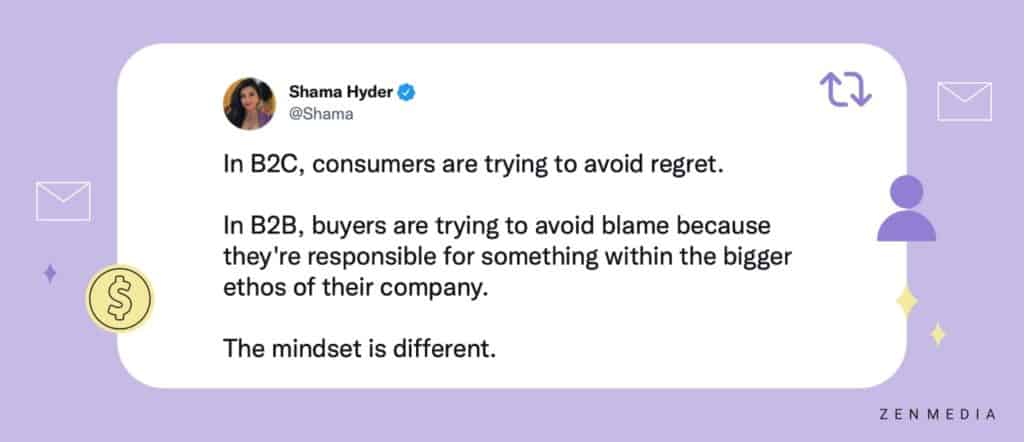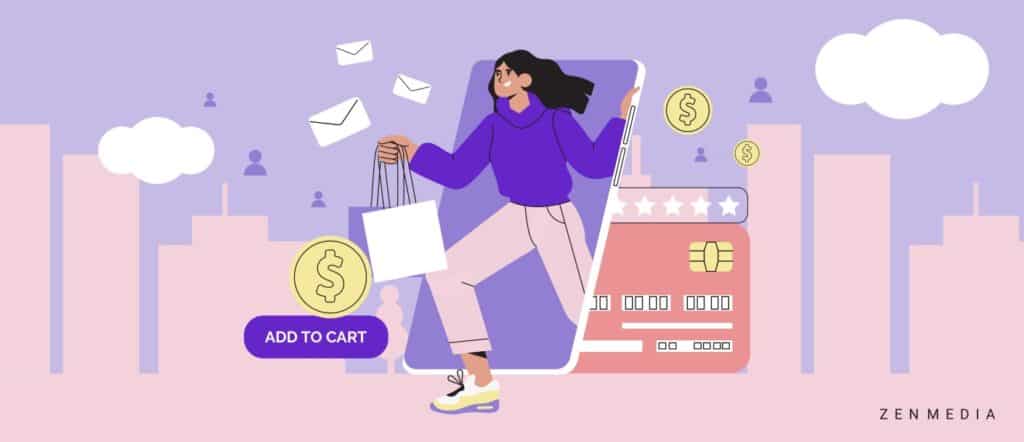The marketing world is transforming yet again. If you don’t want your B2B brand left in the past, keep your finger on the pulse of the B2C scene!
Yes, B2C strategies are (rightfully) more out of the box, unprofessional, and frankly—fun—than B2B strategies, and that is for good reason in many cases.
B2C is for individuals. It’s about our personal lives and who we are when we aren’t “on” for work. So cutesy, silly, edgy, and over-the-top all work, while in B2B, professionalism is important.
But just because we’re professionals doesn’t mean we need to be boring.
Your B2C counterparts are throwing down a strong marketing game, and it’s time to take those ideas and adapt them for B2B.
The New B2B2C
It has long been established that customer expectations for B2B and B2C marketing are starkly different. However, the line between the two areas has started to blur as consumer behaviors continue to reshape and control purchase decision-making habits.
Now that we’ve just about all gone digital, quick and seamless buying journeys have spoiled us rotten with self-service decision-making, allowing us to make purchases on our own time and without pushy sales pitches. The convenience of online shopping that we see in B2C businesses has helped many of them address their audience’s evolving needs. As this industry becomes more efficient, personalized, and simple, customers now expect the same from all of their e-commerce experiences, including B2B brands.
However, B2B’s nuances and complexities have slowed this sector’s transformation into a more digital landscape. While a B2C customer’s biggest fear when making a purchase is regret, B2B buyers have more at stake. If you make the wrong purchase as a B2B buyer, you are likely spending tens of thousands of dollars on something you will have to explain and justify to your boss or the company CFO. And if your CFO doesn’t agree with your decision, that could negatively affect your career.
The weight of that decision is huge.

So yeah, “silly” isn’t necessarily going to seal the deal for a B2B buyer looking at a major purchase—but boring won’t seal the deal either.
The best way to make sure your B2B marketing is resonating with your buyers?
Look into buyer behavior trends.
Adapting to Changing Buyer Behaviors
The new B2B buyer is smarter, more independent, and more capable than ever before. Just like consumers, B2B buyers are adept at Googling, surfing websites, reading reviews, and chit-chatting the pros and cons of products on Dark Social (Slack, instant messaging apps, Reddit, Discord, and more).
The difference? While a B2C client may spend a weekend comparing a Samsung TV against an LG before clicking “add to cart” on Amazon, B2B buyers spend months—if not years—weighing their options.
The No-Salespeople Sales Funnel
Even more important—buyers, whether B2C or B2B, don’t want to talk to salespeople.
B2B buyers spend 70% of the sales cycle performing independent research, comparing different products, and making pros and cons lists before they ever bother reaching out to a company. That means you have to make it onto their shortlist for your sales team to even get a pitch in.
And that means—sales are made in marketing.
The better the marketing, the more likely you make it on the shortlist (normally, only two or three do), and the more likely you seal the deal.
So, how does buyer behavior tell us we need to market?
Related Reading: Creating an Earlier Buyer Journey: Why It Matters, and Why You Should Be Reaching Out
B2C Marketing Strategies for B2B Marketers to Adopt
Omnichannel Marketing
Our world has become increasingly hybrid—look at how we work. This shift to a digital normal has affected consumer demands, pressuring companies to become more flexible than ever.
B2C brands have adopted an omnichannel strategy to prevent them from delivering a disjointed customer experience.
Sure, companies can have websites, blogs, and social media accounts, but it’s not an omnichannel approach if these important resources are not working together to present a shared voice, story, and message.
Related Reading: What is the Customer Buying Journey?
No matter where they want to find their information, on social, through google, or at a trade show, buyers have a much higher degree of autonomy and can decide when they engage with a product or service. This is why an omnichannel approach is key.
The influx of mobile technology and increased social media usage are the main drivers of consumption and purchasing. Spaces previously reserved to separate personal connections and business relationships for the consumer environment have merged and are now game changers in B2B PR and marketing.
In the end, you need to be everywhere to make sure you are easily and always in front of your buyers. Using an omnichannel approach, you can ensure you are in consideration just based on name recognition and recall.
Personalization
People want to feel like people, which is easier to accomplish within B2C. They want to relate to the brands they’re buying from, feel an emotional connection, and identify with your company’s culture and values.
B2Cs do a great job of creating welcoming and relatable marketing experiences. Think about Coca-Cola’s personalized Coke bottle ad campaign or their digital campaigns that show Coke drinkers around the globe. When you engage with their brand, you feel like you are a part of something, and yet—you are individualized.
This is easier said than done in the B2B space, but the idea is the same. Regardless of whether you are in B2C or B2B—in the end, you are a person selling to a person. The key is how you or your product or service can improve that person’s (or the people they oversee) work-life better.
Focusing on how you solve a real problem is key to helping your buyer build an emotional connection with your brand. When they hear your brand’s name, see your brand’s logo, or read your blog, they should feel: relieved because their problem is solved; inspired because you’re helping them be more creative, efficient, or successful; excited because you are changing their perspective on how they engage in their industry.
Related Reading: The Importance of Connecting With Your Audience in Marketing
Anything from document processing to legal consulting can be emotional if you tie it to how it will benefit your buyer.
But even with the best problem-solving product on the market, it’s challenging for your audience to connect with a faceless B2B brand.
So put a face on the work you do.
Take a note from your B2C marketers, and show people engaging with your product. This can be in the form of video demos on your website, fun employee posts on your LinkedIn account, or customer shoutouts. The key here is to show people engaging positively with your brand so that your buyers can envision themselves having a positive experience with your brand.
Third-Party Validation
You can have the most amazing marketing campaign in the world, but if your reviews are one-star… it doesn’t matter.
Decision-makers in your target audience are more likely to look at your press and online reviews than they are to remove the cleverly crafted blog post on your website (and we say this as blog enthusiasts). How your buyers’ peers feel about your product is just as important as the product itself and your brand’s messaging surrounding it.
It’s common to see reviews and feedback about products from B2C brands (hello, Amazon 5-star reviews), but that trend is starting to creep into B2B as well, and for a good reason. No one wants to have a bad experience.
B2B leaders must be mindful of how consumers view their business and should address their feelings, good or bad. A brand could have a great deal of supporters, but a single instance of bad press could potentially destroy their business—yikes. A well-known example of this phenomenon is SeaWorld.
Related Reading: How to Win People and Influence B2B Customers
SeaWorld is known for its theme park and waterpark experiences, especially the dolphin and orca whale performances. However, following the 2013 debut of CNN’s Blackfish documentary, which focused on the captive orca that killed its trainer in 2010 and the cruel treatment of orca whales in the park, SeaWorld’s reputation started to decline. The aftermath resulted in SeaWorld’s stock market price decreasing by 33% a year later, even as officials announced their costly initiative to expand the orca whale enclosures. In 2016, SeaWorld announced it would stop its orca breeding program. People all around the world still boycott the company today.
All it takes is one negative peer review, comment, or exposé to tank a company, and that’s especially true in the B2B space. People trust other people, which is why third-party reviews can influence others to invest in your brand or dissuade them from engaging. Buyers realize they are spending more money and have more on the line, so they’ll listen to key influencers, publications, podcasts, and whoever else is in the space. According to ReviewTrackers, 94% of consumers say a bad review has convinced them to avoid a business. Reviewers in spaces like Yelp and Google Reviews will have the majority of control over defining what their product or service is. Without a strong PR story and a solid media presence, your brand is as good as gone.
Related Reading: How Your B2B Can Leverage User-Generated Content To Build Credibility
Embrace the New B2B Customer Experience
Like any customer, whether in B2B or B2C, buyers want a convenient, positive experience from a business that aligns with their values and proves they’re trustworthy. How they contribute to society and affect the communities they serve is a reflection of that business environment and what customers can ultimately expect from them.
For instance, at Zen, DEI matters. We are a woman-founded, minority-founded organization that knows that diversity of experience and thought brings higher levels of creativity and innovation. Inclusive leaders have higher cultural intelligence and the necessary skills to communicate effectively with both employees and clients of different backgrounds. Brands need to be clear about not just WHAT they believe but how they put those beliefs into practice.
Related Reading: Diversity, Inclusion & Equity: Key Differences & Why They All Matter
While they still have substantial distinctions, both sectors can learn a lot from each other. Ultimately focusing on people and fulfilling their needs and expectations will propel your business forward. B2C companies have already adapted to these trends, and B2B brands can greatly benefit from incorporating these shifts into their marketing tactics.




